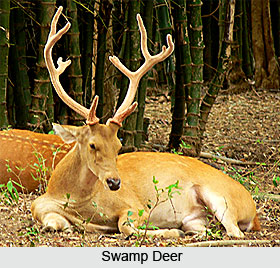 Swamp Deer is large, stags attaining a weight of one hundred and seventy kilograms and more and a shoulder height of one hundred and twenty five centimetres. The characteristic antlers of a stag sweep upward for over half their length before branching; many have twelve tines, the basis for the animal`s Hindi name barasingha. In former times the deer ranged throughout the Indus, Ganga, and Brahmaputra river basins and as far south as the Godavari river in central India. Today it is extinct along the Indus, and survives primarily in a few reserves elsewhere.
Swamp Deer is large, stags attaining a weight of one hundred and seventy kilograms and more and a shoulder height of one hundred and twenty five centimetres. The characteristic antlers of a stag sweep upward for over half their length before branching; many have twelve tines, the basis for the animal`s Hindi name barasingha. In former times the deer ranged throughout the Indus, Ganga, and Brahmaputra river basins and as far south as the Godavari river in central India. Today it is extinct along the Indus, and survives primarily in a few reserves elsewhere.
Being almost exclusively grazers and preferring the vicinity of water, swamp deer are found principally on grasslands near rivers, a habitat which has been almost completely converted to agriculture. The finest remaining deer populations are found in the Sukla Phanta reserve in Nepal, the Dudhwa National Park in Uttar Pradesh and the Kaziranga National Park in Assam, all three supporting a total of about three thousand animals. These northern deer are considered to be a different subspecies (Cervus duvauceli duvauceli) from the ones in central India , where a viable population of about three hundred survives only in Kanha National Park.
Swamp Deer are social animals; as many as nine hundred having been seen together, except that stags frequently wander alone and females become solitary when fawning. At the time of rut many may congregate at a favourite meadow. The time of rut varies, reaching a November peak in Nepal and a January one in central India. Several distinctive behaviour patterns are associated with the rut. At dawn and dusk, stags bugle, a mournful tow-toned note, repeated ten or more times. Stags also wallow in muddy depressions. Many stags use the same wallow whose location is traditional year after year.
A Swamp Deer stag does not collect a harem of females. Instead, many stags gather near the females and establish a rank order among them. The dominant stag has priority to an estrous female. Both intimidation and direct aggression are used to achieve or maintain rank. A stag may approach another with a stiff gait, his muzzle raised high, making himself impressive. Or he may lower his antlers and spar. Such fights are seldom serious, the animals merely testing strength or reasserting themselves. True dominance battles are violent affairs, antlers clashing and sod flying.
After the rut, stags drop their antlers, beginning to do so in March in northern India and in May in central India. After a gestation period of two hundred and forty to two hundred and fifty days, females have a single young. Females have their first young at the age of three years and one young per year thereafter.











